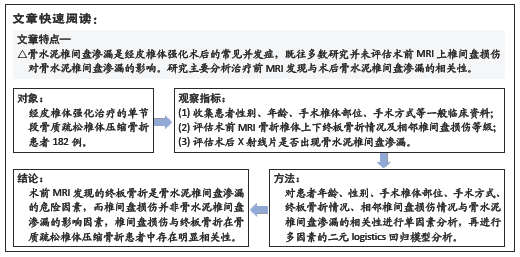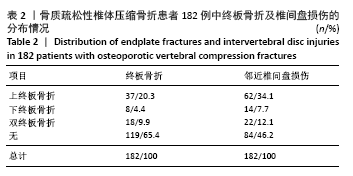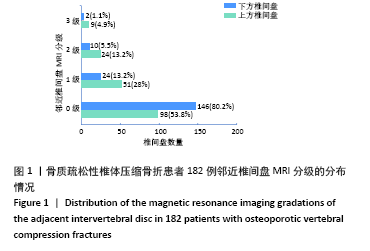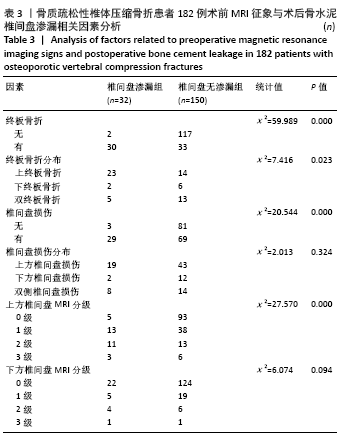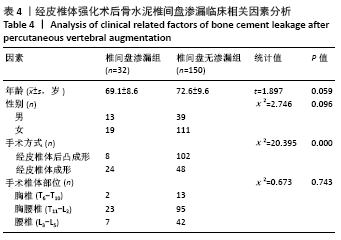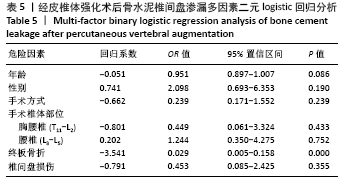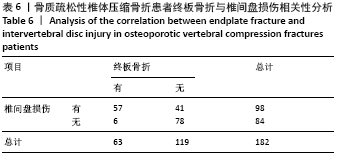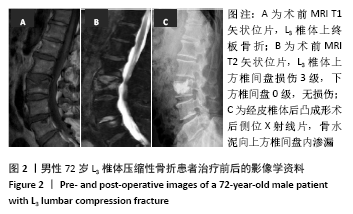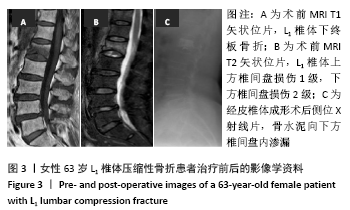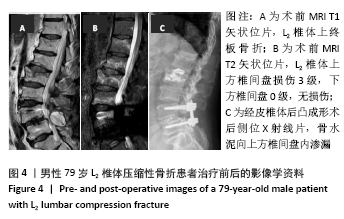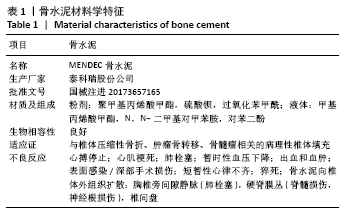[1] 中华医学会骨科学分会骨质疏松学组.骨质疏松性骨折诊疗指南[J].中华骨科杂志,2017,37(1):1-10.
[2] CHEN WJ, KAO YH, YANG SC, et al. Impact of cement leakage into disks on the development of adjacent vertebral compression fractures. J Spinal Disord Tech. 2010;23(1):35-39.
[3] 蔡金辉,刘庆余,阮耀钦,等.经皮椎体强化术后骨水泥椎间盘渗漏与邻近椎体骨折的相关性分析[J]. 中国脊柱脊髓杂志,2018,28(8):713-719.
[4] 刘军,张陆,刘志昂,等.经皮椎体增强术后邻近椎体再骨折的相关因素[J].中国矫形外科杂志,2020,28(4):319-322.
[5] NIEUWENHUIJSE MJ, PUTTER H, VAN ERKEL AR, et al. New vertebral fractures after percutaneous vertebroplasty for painful osteoporotic vertebral compression fractures: a clustered analysis and the relevance of intradiskal cement leakage. Radiology. 2013;266(3):862-870.
[6] JAMJOOM B, PATEL S, BOMMIREDDY R, et al. Impact of the quantity of intradiscal cement leak on the progression of intervertebral disc degeneration. Ann R Coll Surg Engl. 2017;99(7):529-533.
[7] HONG SJ, LEE S, YOON JS, et al. Analysis of intradiscal cement leakage during percutaneous vertebroplasty: multivariate study of risk factors emphasizing preoperative MR findings. J Neuroradiol. 2014;41(3):195-201.
[8] MIROVSKY Y, ANEKSTEIN Y, SHALMON E, et al. Intradiscal cement leak following percutaneous vertebroplasty. Spine (Phila Pa 1976). 2006;31(10): 1120-1124.
[9] ZHONG BY, HE SC, ZHU HD, et al. Nomogram for Predicting Intradiscal Cement Leakage Following Percutaneous Vertebroplasty in Patients with Osteoporotic Related Vertebral Compression Fractures. Pain Physician. 2017;20(4):E513-e520.
[10] 蔡金辉,刘庆余,曾玉蓉,等. MRI预测经皮椎体强化术骨水泥椎间盘渗漏的价值[J].中国医学影像技术,2017,33(7):1061-1065.
[11] ORTIZ AO, BORDIA R. Injury to the vertebral endplate-disk complex associated with osteoporotic vertebral compression fractures. AJNR Am J Neuroradiol. 2011;32(1):115-120.
[12] FUJIWARA T, AKEDA K, YAMADA J, et al. Endplate and intervertebral disc injuries in acute and single level osteoporotic vertebral fractures: is there any association with the process of bone healing? BMC Musculoskelet Disord. 2019;20(1):336.
[13] GALIBERT P, DERAMOND H, ROSAT P, et al. Preliminary note on the treatment of vertebral angioma by percutaneous acrylic vertebroplasty. Neurochirurgie. 1987;33(2):166-168.
[14] COTTEN A, DEWATRE F, CORTET B, et al. Percutaneous vertebroplasty for osteolytic metastases and myeloma: effects of the percentage of lesion filling and the leakage of methyl methacrylate at clinical follow-up. Radiology. 1996;200(2):525-530.
[15] PHAM CT, CLARENçON F, GANEM G, et al. Spinal cervical metastasis from a glioblastoma multiform treated by percutaneous vertebroplasty: a case report. J Neuroradiol. 2011;38(5):323-325.
[16] COHEN M, ZEITOUN D, BLANPAIN S, et al. Percutaneous vertebroplasty of the C2 body and dens using the anterior oblique ascending transdiscal approach. J Neuroradiol. 2013;40(3):211-215.
[17] CHUROJANA A, SONGSAENG D, KHUMTONG R, et al. Is intervertebral cement leakage a risk factor for new adjacent vertebral collapse? Interv Neuroradiol. 2014;20(5):637-645.
[18] LEE KA, HONG SJ, LEE S, et al. Analysis of adjacent fracture after percutaneous vertebroplasty: does intradiscal cement leakage really increase the risk of adjacent vertebral fracture? Skeletal Radiol. 2011; 40(12):1537-1542.
[19] SEMAAN H, OBRI T, BAZERBASHI M, et al. Clinical outcome and subsequent sequelae of cement extravasation after percutaneous kyphoplasty and vertebroplasty: a comparative review. Acta Radiol. 2018;59(7):861-868.
[20] PITTON MB, HERBER S, BLETZ C, et al. CT-guided vertebroplasty in osteoprotic vertebral fractures: incidence of secondary fractures and impact of intradiscal cement leakages during follow-up. Eur radiol. 2008;18(1): 43-50.
[21] SHEN M, NIU J, ZHOU H, et al. Adjacent disc height reduction and clinical outcome after intradiscal cement leakage. Int J Spine Surg. 2016;10(2016): 34.
[22] 倪才方,赵辉,陈珑,等.两种骨水泥渗漏对椎间盘影响的实验研究[J].中华骨科杂志,2007,27(4):263-267.
[23] HIWATASHI A, OHGIYA Y, KAKIMOTO N, et al. Cement leakage during vertebroplasty can be predicted on preoperative MRI. AJR Am J Roentgenol. 2007;188(4):1089-1093.
[24] KOH YH, HAN D, CHA JH, et al. Vertebroplasty: magnetic resonance findings related to cement leakage risk. Acta Radiol. 2007;48(3):315-320.
[25] 王立,钟润泉,郭东明,等.应用MRI预判经皮椎体增强术中骨水泥的邻近椎间盘渗漏[J].实用医学杂志,2010,26(13):2358-2361. |
